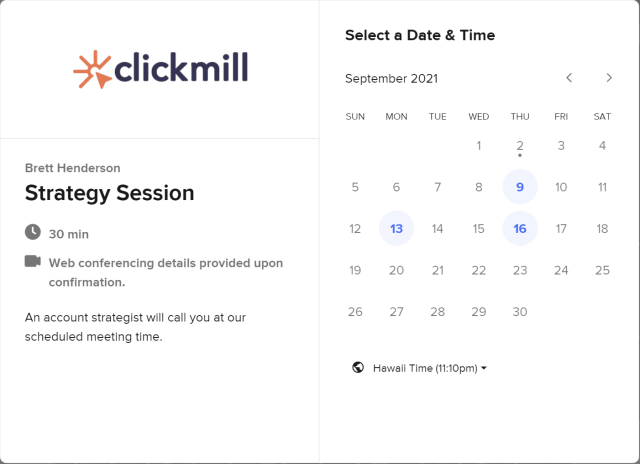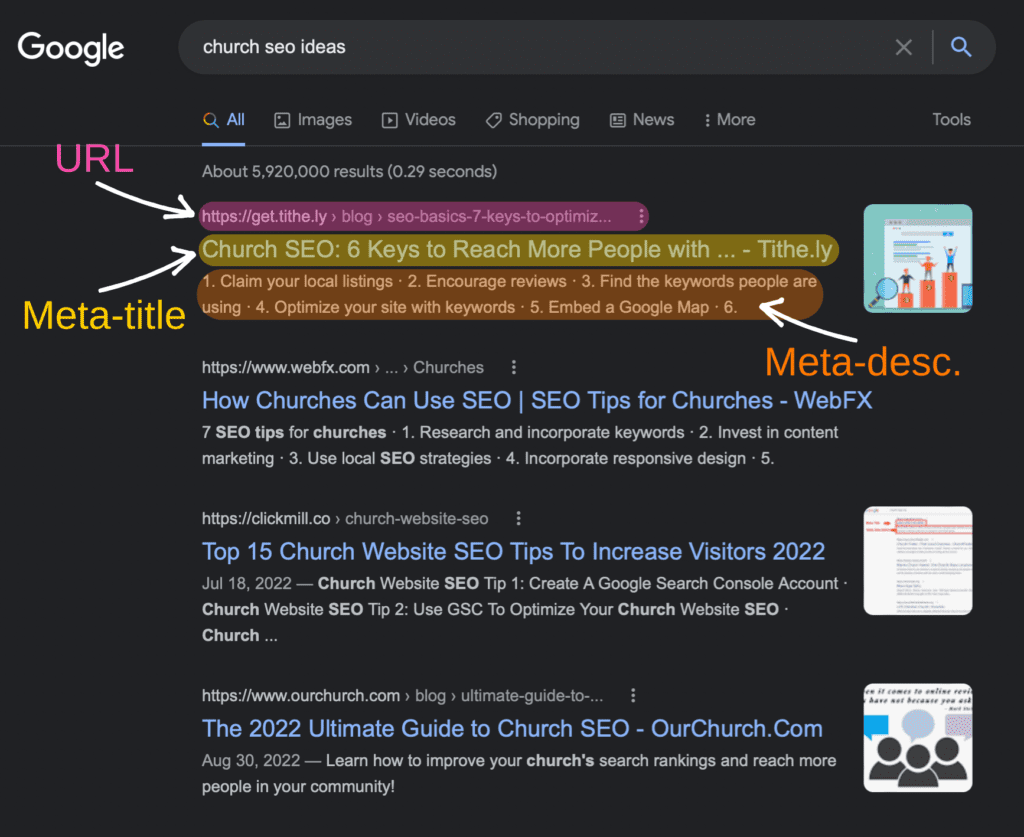Church SEO helps bring more visitors to your church website. Use key words, add useful links, keep people on the site longer, and make sure it loads fast. These steps attract more visitors and make their online visit better.
Let’s face it, Church SEO is difficult. This scenario may be familiar:
You spend hours crafting a website for your church, doing everything you can to make it helpful and easy-to-navigate for new visitors. However, despite your best efforts, your church website gets little to no visitors.
So how do you get visitors to visit your website?
Many people would answer that you get visitors by making a website that is visually appealing, and this mentality leads to many great church websites. However, the best church websites don’t rely solely on visual appeal to draw in traffic.
In this article, we will talk about church SEO and how you can use it to increase your church website’s viewership. Let’s get into it.
What is Church SEO?
Church SEO stands for church search engine optimization.
Every search engine has an algorithm that it uses to determine which content to show to which people. Regardless of the quality of your website, the search engine will not show it to people if it doesn’t meet any of its algorithm’s criteria.
Church SEO is the process of adding in the things that the algorithm is checking for, so that your content will be shown to more people.
(Side note: different search engines have different algorithms, so make sure to optimize your content according to the specific search engine that you’re using.)
When done correctly, church SEO will increase the number of viewers on your ministry website.

Get A Proven Marketing Plan That Increases Enrollments When You Book A Call Today!
Receive customized advice to help your school attract more families!
How To Use SEO For Churches
What do algorithms look for in a website?
The short answer is that algorithms look for keywords. Most algorithms are heavily influenced by keywords, so it is a good rule of thumb to include keywords in your content regardless of which search engine you intend to use.
The long answer is that algorithms look for keywords, links, dwell time, engagement, and site load speed. Furthermore, different algorithms weigh these different criteria differently, meaning that one criteria might be a big factor in a certain algorithm, while it is a lesser factor in another algorithm.

Let’s unpack the different criteria and how they could be implemented into your websites.
Church SEO Criteria 1: Placing Keywords
One common misconception about keywords is that they have to be one word, but in actuality, a keyword is any word or phrase that is entered into a search engine. Because they are the primary method through which search engines match searches and content, keywords are a large factor in determining whether or not your website gets seen.
For example, you could write a whole article about overcoming doubt as a Christian, but if you don’t write it in terms that the algorithm can recognize and match to searches (keywords), you won’t be able to reach anyone with that article.
That is why it is important to do keyword research and put church SEO keywords into your content.
Keyword research is the process of using tools such as KWFinder or Semrush to determine which keywords are most popular. The most popular keywords have the most searches, and adding them to your content will draw searches to your content.
For more information on how to use keyword research to increase your church website traffic, check out this helpful guide here: Digital Evangelism: The Lowest Hanging Fruit In Digital Ministry
But it’s not just about putting in keywords, it’s about where you put them. Certain search engine algorithms prefer front loaded keywords, so content with the keyword right at the beginning will be shown to more people.

Get A Proven Marketing Plan That Increases Enrollments When You Book A Call Today!
Receive customized advice to help your school attract more families!
Your search engine ranking will also be improved if you add the keyword multiple times throughout the content instead of just putting it in once. However, you should be careful to avoid keyword stuffing your content, because the algorithm actually avoids showing things with too many keywords.
Finally, you should strategically place church SEO keywords in the meta-title, meta-description, title, and headings. While the title and headings are fairly self-explanatory, the meta-title and meta-description are less commonly known.
The image will help explain these terms:

Your content shows up in the search engine as a listing. A listing consists of a URL, a meta-title, and a meta-description. You should try to put keywords into each of these things, although some search engines will not allow you to edit the URL (i.e. youtube).
When you add keywords to the URL, meta-title, meta-description, title, and headings, it will be more significant to the algorithm than if you had just added keywords to the text.
If you are enjoying this post – you will really love our ultimate guide to church marketing titled, Digital Marketing For Churches: #1 Church Marketing Guide.
Church SEO Criteria 2: Adding Links
There are two kinds of links that you can add to your content to improve its search engine ranking:
- Internal links
- External links

Internal links are links that lead to other pages or posts within your own website. External links are links that lead to other websites. When you have both internal links and external links within your content, the algorithm will be more likely to show it to more people.
It also helps to have links leading to your website on other websites, but that is not something you can easily control.

Get A Proven Marketing Plan That Increases Enrollments When You Book A Call Today!
Receive customized advice to help your school attract more families!
Church SEO Criteria 3: Increasing Dwell Time
Dwell time is a term that refers to how long visitors spend on your website, on average. It is closely linked to word count, because people are more likely to spend a long time on something if it contains a lot of information for them to take in.

One of the algorithm’s goals is to improve the search engine’s reputation by only showing quality content. Whether or not the algorithm actually succeeds at filtering for quality content is up for debate, but we can agree that many of the algorithm’s selections are influenced by this goal.
This concept applies to dwell time, because if people are willing to spend a long time on a site, then that tells the algorithm that it is probably good content that it should keep showing to more people.
Church SEO Criteria 4: Boosting Engagement
Similarly, engagement is an indicator of a website’s quality. If visitors frequently interact with the website (comments, likes, etc.) and receive responses, then the algorithm will consider it a good site to show to more people.

You can use this to benefit your own ministry website by adding some sort of engagement feature and responding consistently to visitors. Generating engagement will help increase your church website traffic.
If you have a small church, this is an area you can excel in. Small churches are known for the attentive, personal care they provide to each of their members, and this quality can be translated into small church websites.
Getting people engaged online is one thing, but getting people to engage in your ministry can be much more difficult. Check out our article on church engagement here to learn how to involve your congregation in ministry: Commitment To The Church: Top Church Engagement Strategy [2022]
Church SEO Criteria 5: Site Load Speed
Site load speed is a term that refers to how long it takes a site to load after someone has clicked on it. A slow load speed is generally bad because it can cause people to give up on your site before they’ve even seen it, but it also harms your search engine ranking.
If your website is frustrating and problematic because it takes too long to load, then the search engine won’t show it to people.

Get A Proven Marketing Plan That Increases Enrollments When You Book A Call Today!
Receive customized advice to help your school attract more families!
Unfortunately, slow load speeds can be a difficult problem to fix. Your website tends to slow down when it has more content than it can handle. It might also load slowly if the visitor is trying to access it from a place that is far from the server.
One way to increase your load speed is to compress your images. Usually, 4k quality images are not needed on your website. Using lower resolution images can help your website load faster without drastically reducing the quality of your pictures.
Another way to increase load speed is through the use of Content Delivery Networks (CDNs). As aforementioned, if a visitor tries to access your website from a location that is far from the server where your site is hosted, it will take a while for the information to travel to their computer and back.
However, a CDN essentially allows people to quickly access your website from all over the world with proxy servers.

If these things don’t improve your site load speed, there are more drastic measures you can take. One such measure is changing your website host, because a poor quality website host might also be the cause of your slow load speed.
Church SEO Review:
You can think of being on the internet like being in a river. As the current guides the river’s flow, so does the algorithm guide viewers to content. As you put out content, you can either fight the current or use it to reach viewers.

When you ignore church SEO and make your content based on whatever feels right, you are fighting against the current. People might see your content, or they might not, but the search engine won’t be showing it to many people, because it doesn’t meet the criteria of its algorithm.
However, when you apply church SEO to your ministry website by adding keywords and links, and also by improving engagement and site load time, you use river’s current to propel yourself to your goal. Because your content meets the algorithm’s criteria, the search algorithm will work for you by showing your content to more people.
Comment below which of these tips you want to implement into your website.
Don’t forget to check out our video, which gives an in-depth look at how to use meta-titles and meta-descriptions to grab your audience’s attention.

Responses
[…] If you’d like to learn more about keywords and algorithms, check out our other post here: Best Church SEO: Boost Website Traffic With SEO For Churches […]